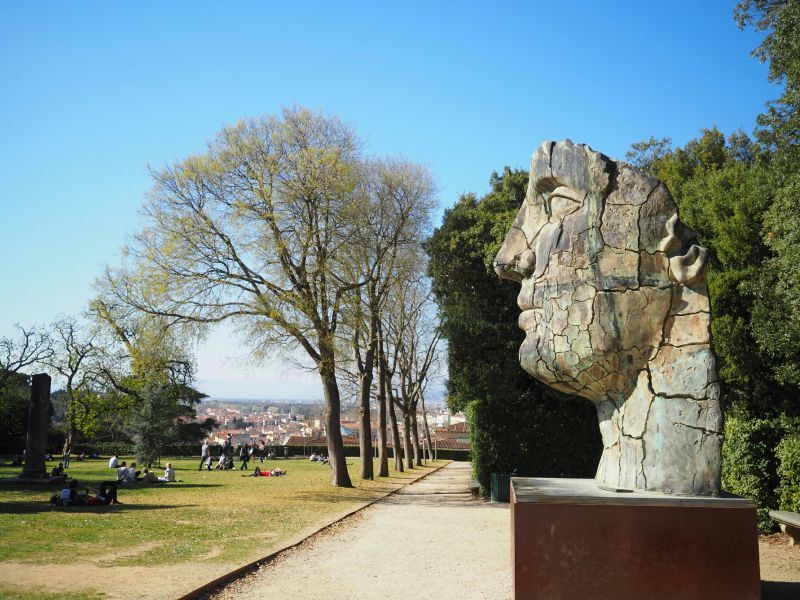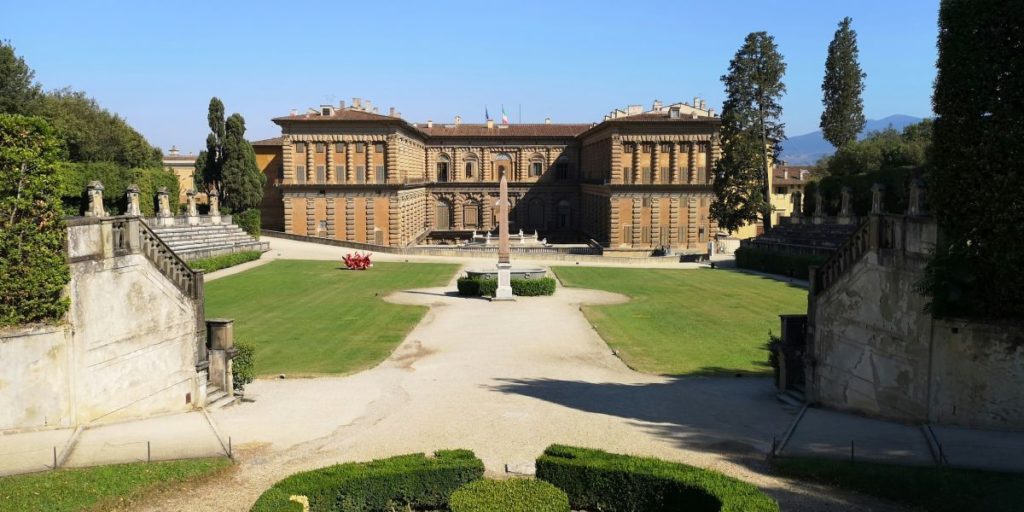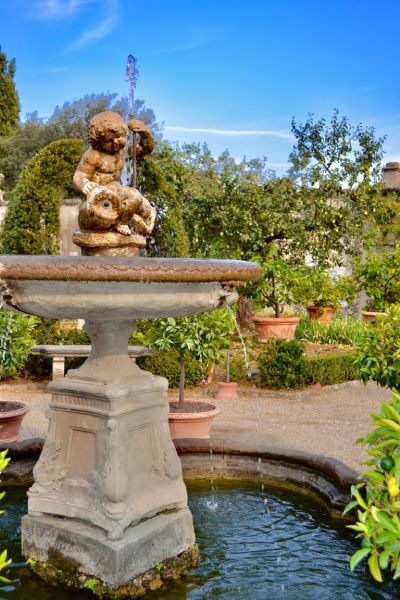
Step into a realm where nature’s tranquility meets the grandeur of noble ambition at the Boboli Gardens. This pristine expanse of meticulously sculpted landscapes offers a breath of fresh air right in the urban embrace. Beyond the walls of the Pitti Palace, an enchanting world of green paths, ornate fountains, and living sculptures unfold—take a leisurely stroll within these historic grounds, and you’ll find yourself lost amidst the wonders that have inspired countless onlookers for generations.
📍 Address
Piazza de’ Pitti, 1, 50125 Firenze FI, Italy
⏳ Opening hours
Opening hours here
🔗 Website
https://www.uffizi.it/en/boboli-garden
💰 Cost
Low Season Prices: full €6.00, reduced €2.00
High Season Prices: full €10.00, reduced €2.00
Full explanation here


Where Are the Boboli Gardens?
How to Get There
Nestled in the heart of Florence, behind the majestic Pitti Palace, the Boboli Gardens are an integral part of the Oltrarno district. Worry not about finding your way; Florence is a walkable city. But if you’re coming from afar:
By Foot:
From Florence’s centre, it’s a scenic walk across the Ponte Vecchio towards the Pitti Palace.
By Bus:
Grab a seat on ATAF lines 11, 36, or 37, hop off at the Pitti stop, and Boboli is just behind the palace.
By Car:
It’s central Florenceparking can be tricky. Aim for paid parking areas like the Oltrarno’s Piazza della Calza.
Here’s a local tip – grab a gelato from a nearby ‘gelateria’ before entering the gardens. You’ll thank me once you’re sitting by a fountain, taking in both the sights and the sweet Florentine flavors!
Boboli Gardens: Essential Details
Opening Hours
- November through February: 8:15 AM to 4:30 PM
- March & October: 8:15 AM to 5:30 PM
- March (with Daylight Savings Time), April, May, September, October (with Daylight Savings Time): 8:15 AM to 6:30 PM
- June, July, August: 8:15 AM to 7:30 PM
Click here for the latest updates on timings as they can change depending on the month and cultural events.
Duration of Visit
Give yourself a good half-day to wander through the different areas and take in the serenity mixed with historical magnificence.
Best Time to Visit
Spring and autumn are magical here, with a perfect mix of pleasant weather and vibrant colors.
Boboli Gardens Ticket Options
Visiting the Boboli Gardens in Florence offers various ticket options to suit different needs.

Low Season Prices (10 January – 20 February & 10 November – 20 December)
Full Price: 6 €
Reduced Price: 2 €
High Season Prices (21 December – 9 January & 21 February – 9 November)
Full Price: 10 €
Reduced Price: 2 €
Special Tickets
5 Days Ticket (all museums): Full – 18 € (low season), 38 € (high season)
Pitti Palace + Boboli Gardens: Full – 14 €
Extra Fee for Groups (11+ persons, only The Uffizi): 70 €
Annual Subscriptions
Boboli Gardens: 25 € (Unlimited priority admission for 1 year)
Includes access to the Porcelain Museum
Booking Information
Booking Costs: € 3 for Boboli Gardens
Online Booking: Via B-ticket platform
Phone Booking: Call +39 055294883
Booking in Florence: Available at various ticket offices
Free-Admission Days/Time Slots
Special conditions apply, including priority for disabled visitors and school groups
Reduced-Price Tickets
2 € for EU citizens (over 18 and under 25), and select non-EU countries
Additional Notes
– Free admission for children under 18, disabled persons, scholars, students, teachers, tour guides, journalists, and certain other categories
– School groups have specific reservation and admission rules
– Annual subscriptions offer priority admission but are subject to certain conditions
– Combined tickets available for Uffizi, Pitti Palace, and Boboli Gardens
What’s So Special About the Boboli Gardens?
Immerse yourself in the Boboli Gardens and you’re not just visiting another park—you’re traversing the plush, green carpets once exclusive to Tuscan high society. This sprawling expanse, replete with elaborate sculptures, ornamental fountains, mysterious grottos, and diverse botanical treasures, is a universe of fantasies cleverly crafted into reality.
As if every pathway were curated to evoke elegance, each vista to rival a canvas, the gardens invite you to explore and luxuriate in the living, breathing masterpiece that once entertained nobility. This carefully orchestrated natural realm is a silent yet eloquent testament to the ambition and artistic vision of its erstwhile patrons.
History Comes Alive
Initiated in the 16th Century as a testament to luxury and prestige, the Boboli Gardens epitomize the Italian garden style, which has left an indelible mark upon countless European royal estates. Intricately designed, these gardens fuse nature’s random beauty with the precision of human intent, resulting in a landscape that whispers tales of bygone grandeur. The Medici family, ever the patrons of the arts and architecture, shaped the Boboli Gardens into a symbol of their legacy, crafting an outdoor domain that mirrored the might and magnificence of their rule.
Art in Nature
The Boboli Gardens double as an open-air museum showcasing a collection spanning centuries, from the glory of Roman antiquity through the flourish of the baroque. Every sculpture holds a narrative—a frozen-in-time expression of the sculptor’s craft and the Medici’s taste. You’ll encounter masterpieces like Giambologna’s touching mythological scenes, and before the majestic Fountain of Neptune, you may contemplate the visual stories the chiseled marble conveys, as water flows endlessly, animating the silent figures.
Panoramic Vistas
Rising from their urban setting, the Boboli Gardens offer a series of panoramic terraces where the eye leaps from the verdant grounds to the iconic cityscapes beyond. A climb to the heights near the rococo Kaffeehaus pavilion rewards visitors with a grandstand view that stretches outward to the undulating hills beyond. This strategic location articulates a dialogue between the serenity of nature and the urban tapestry, creating a perfect spot for reflection or for photographers eager to capture the timeless beauty of the panorama.
Theatrical Settings
The Boboli Gardens are not strangers to spectacle, exemplified by the impressive Amphitheatre. Here, an ensemble of an Egyptian obelisk and Roman artifacts forms the dramatic core of historic social gatherings and performances. The grandeur of the Amphitheatre remains a manifest of the Medici’s love for the arts and their inclination to blend cultural entertainment with the splendor of their surroundings. The very space, once animated by the footsteps of actors and the laughter of audiences, continues to echo the vibrancy of festivals past in its architectural dignity and aura of lingering exuberance.
Stroll Through the Boboli Gardens
Admire the Art and Statuary
Take your time to discover the various sculptures that blend seamlessly with the foliage. Each statue has a story, each fountain a whispered secret of the past.
The Grotta Grande
Designed by Buontalenti, this grotto is a splendid display of Mannerist art, complete with stalactites and intriguing sculptures.
The Museums
Yes, the gardens host museums! The Porcelain Museum, located in the Casino del Cavaliere, houses a fine collection of ceramics. Meanwhile, the nearby Costume Gallery showcases fashion across the centuries.
Garden’s Architecture
Every hedge seems perfectly trimmed, and every angle is designed to offer a feast for the eyes. The symmetry and order reflect the Renaissance quest for harmony and perfection.
Escape the Crowds
Even on busy days, you can find your slice of tranquility. The further you venture from the main entrance, the more peace you’ll encounter.
As locals, we always remind friends to wear comfortable shoes and bring a camera – your senses will be bombarded with beauty and elegance, and you’ll want to capture it all. Enter from the main gate next to the Pitti Palace and let your journey begin.
And remember, the Boboli Gardens are not just a garden; they are a symbol of Florence’s enduring beauty and history, a place that continues to inspire and enchant visitors with each passing century. Enjoy your visit, and don’t rush – let the Boboli work its timeless charm on you.

